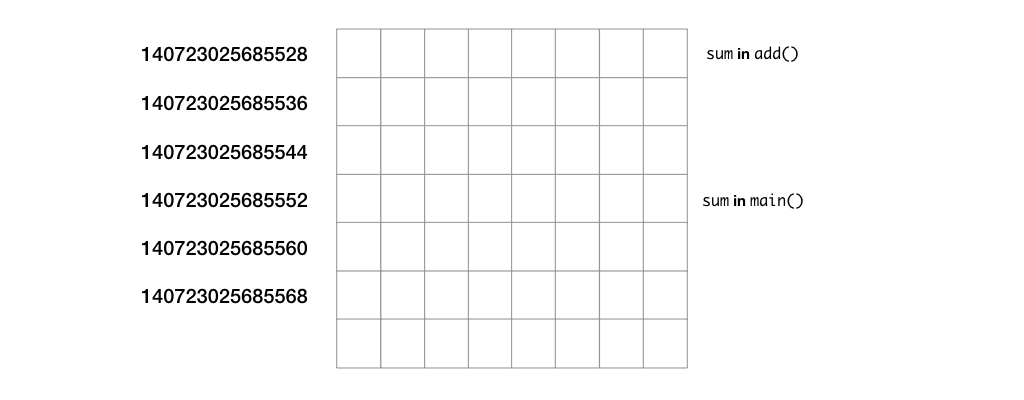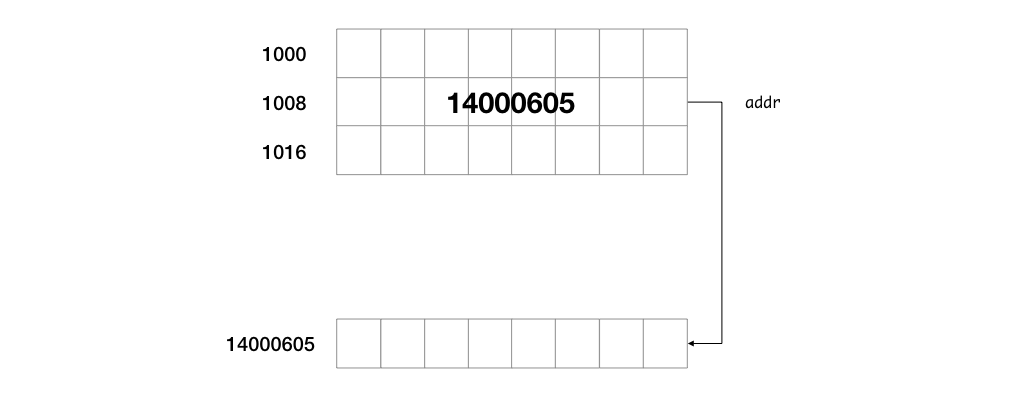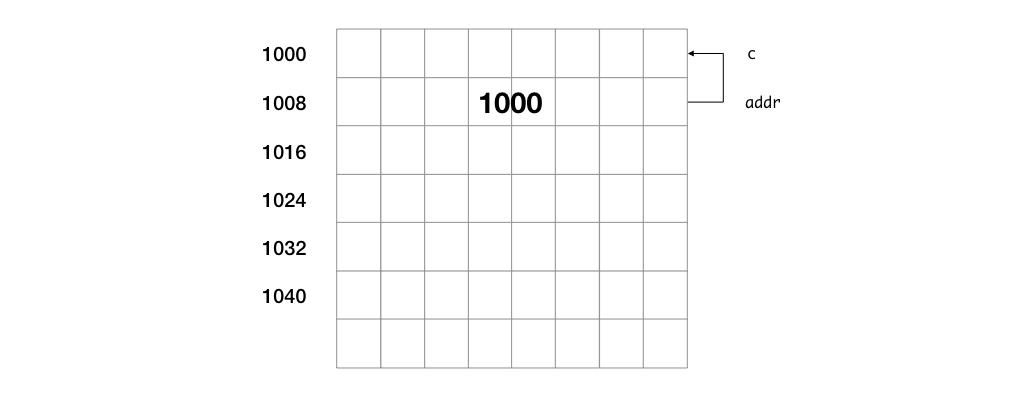Unit 15: Pointers
Learning Objectives
After this unit, students should:
- understand what the address-of operator,
&, represents and what is its type - be able to use the
&operator to access the address of a variable - understand what the dereference operator,
*, represents - be aware that there is a pointer type associated with each type in C and that when
*is used in the variable declaration it has a different meaning to the dereference operator - be able to define pointer type variables and use the
*operator, including:- declaration of a pointer type variable
- assigning an address (of the appropriate type) to a pointer type variable
- accessing/assigning the value that a pointer variable points at
- assigning a new value by dereferencing a pointer variable
- understand why we cannot only change the address referenced by a variable
- understand the units being stored by a pointer and thus, how arithmetic operations would affect pointers
- be aware of pointers to pointers (and more), and the possibility of multiple levels of dereferencing
- be aware of the
NULLpointer, understand what it represents, and be able to use it
Memory Address
You have learned that each variable must have three things: (i) a name, (ii) a type, and (iii) a value. A variable must be stored somewhere in the memory. Every location in the memory has an address. So, there is a fourth thing that every variable must have: a memory address.
Unlike many higher-level languages, such as Java, Python, and JavaScript, C allows us direct access to memory addresses. This empowers programmers to do wonderful things that cannot be done in other languages. But, it is also dangerous at the same time -- using it improperly can lead to bugs that are hard to track down and debug.
The Address-of Operator
Given a variable, we can get its memory address with the "address-of" operator, denoted by &.
Let say that we have a variable
1 | |
We can refer to the memory address of c with the expression &c. The expression &c has the type "address of a long" and evaluates to a number that corresponds to the memory address of c. Note that "address of a long" and long are two different types to C. In general, the expression &x has the type "address of \(T\)" where \(T\) is the type of variable x.
You have also seen in Unit 14 that a variable that stores a memory address is called a pointer. So we also interchangeably refer to the type of &c as "pointer to a long".
Suppose we want to print out the address of c. We cannot use cs1010_println_long(&c), since the type does not match. The CS1010 library has a function to print a pointer variable, which prints out the address in decimal format.
1 2 3 4 5 6 7 8 9 10 11 12 13 14 | |
Running the program above prints something like this:
1 2 | |
Your results will most likely be different since the OS allocates different regions of the memory to this program every time it is run.

The Dereference Operator
The dereference operator is the reversed of address-of and is denoted by *. Think of this as the "location-of" operator. We use this operator in two places:
- to declare a pointer variable, and
- to reference the location of an address.
You have seen how we can declare a pointer variable in Unit 14. For example,
1 | |
declares a variable addr that is an address to a variable of type double. The way to read this is that *addr (or the memory location of addr) stores a variable of type double, so addr is an address of a memory location containing a double.
Changing the Value via Pointer
Suppose we declare a pointer to a double variable (or, for short, a double pointer):
1 | |
We can use *addr just like a normal double variable:
1 | |
The line above means that, we take the address stored in addr, go to the location at that address, and store the value 1.0 in the location.
This is where things can get dangerous. You could be changing the value in a memory location that you do not mean to. If you are lucky, your program crashes with a segmentation fault error1. We say that your program has segfault. If you are unlucky, your program runs normally but produces incorrect output occasionally.

So, always make sure that your pointer is pointing to the right location before dereferencing and writing to the location.
In the code above, if we write:
1 2 | |
back-to-back, the program will almost certainly segfault, because the pointer variable addr is not initialized, so it is pointing to the location of whatever address happens to be in the memory at that time.
We should point addr to a valid location first, like this:
1 2 3 4 | |

Of course, the above could be simply written as:
1 | |
I am just doing it the complicated way (which you should avoid unless you have good reasons to do so) to demonstrate the concept of pointers.
Note that the two lines:
1 2 | |
can be shorten to:
1 | |
Basic Rules About Using Pointers
-
When we use pointers, it must point to the variable of the same type as that declared by the pointer. For instance,
1 2 3 4 5
double pi = 3.1415926; long radius = 5; double *addr; addr = π // ok addr = &radius; // not okLine 5 above would lead to a compilation error since we try to point a
doublepointer to along.One exception to this rule is the type
void *. A pointer tovoidhas a special place in C and it can be used to point to any other type without type errors. The functioncs1010_println_pointer, for instance, takes in a parameter of typevoid *, hence we can pass a pointer of any type to this function as an argument. -
We cannot change the address of a variable. For instance
1 2 3
long x = 1; long y = 2; &x = &y;We try to set the address of
xto be the address ofy. This is not allowed since the allocation of variables in the memory is determined by the OS, a process we have no control over. -
We can perform arithmetic operations on pointers, but not in the way you expect.
Suppose we have a pointer:
1 2 3 4 5
long x; long *ptr; x = 1; ptr = &x; ptr += 1;Suppose that
xis stored in memory address 1000, after Line 4,ptrwould have the value of 1000. After the lineptr += 1, using normal arithmetic operation, we would think thatptrwill have a value of 1001. However, the semantic for arithmetic operations differ for pointers. The+operation forptrcauses theptrvariable to move forward by the size of the variable pointed to by the pointer. In this example,ptrpoints tolong, assuming thatlongis 8 bytes, afterptr += 1,ptrwill have the value of 1008.We can only do addition and subtraction for pointers.
Note that the array notation
a[i]is synonym with*(a + i).
Pointer of Pointer (of Pointer..)
A pointer variable is also stored in the memory, so it has an address too.
1 2 3 | |
For instance, in the above, ptr would have a memory location allocated on the stack too, and so it has an address, and we can have a variable ptrptr referring to the address of ptr. What would the type of this variable be? Since ptr is an address of long, ptrptr is an address of an address of long, and can be written as:
1 2 3 4 5 | |
This dereference can go on since ptrptr is also a variable and has been allocated in some memory location on the stack. We rarely need to dereference more than twice in practice, but if the situation arises, such multiple layers of dereferencing are possible.
The NULL Pointer
NULL is a special value that is used to indicate that a pointer is pointing to nothing. In C, NULL is actually 0 (i.e., pointing to memory location 0).
We use NULL to indicate that the pointer is invalid, typically to mean that we have not initialized the pointer or to flag an error condition.
Billion Dollar Mistakes
Sir Tony Hoare (the same one whom we met when we talked about Assertion) also invented the null pointer. He called it his billion-dollar mistake. Quoting from him: "I couldn't resist the temptation to put in a null reference, simply because it was so easy to implement. This has led to innumerable errors, vulnerabilities, and system crashes, which have probably caused a billion dollars of pain and damage in the last forty years." As you start to use pointers in CS1010, you will see why it is a pain.
Problem Set 15
Problem 15.1
Sketch the content of the memory while tracing through the following code. What would be printed?
1 2 3 4 5 6 7 8 9 10 11 12 13 14 15 16 17 18 19 20 21 22 23 24 25 26 27 28 29 30 | |
Problem 15.2
What is wrong with both programs below?
1 2 3 4 5 6 7 8 9 10 11 12 13 | |
1 2 3 4 5 6 7 8 9 10 11 12 13 | |
-
I leave it to the later OS classes CG2271 / CS2106 to explain the term "segmentation" and "fault". Interested students can always google and read on Wikipedia. ↩